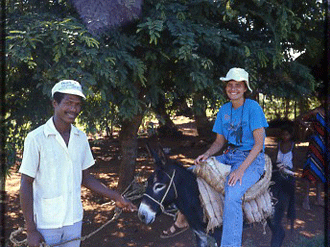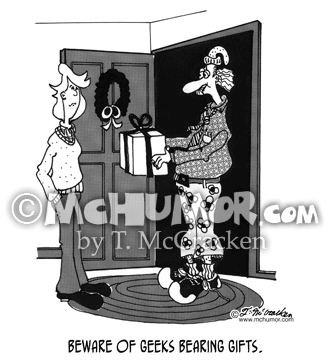My 1989 year-end letter about an unconventional vacation on a tropical island, the Cartoonist Association’s annual cocktail party, and forest fire fighting in Hells Canyon.
December 1989
Dear Friends and Family,
I treated myself to a tropical island vacation this year: a trip to the Dominican Republic during hurricane season. The people were the best part of the trip. They were all very friendly and did their best to not laugh too hard when I thought I was asking in Spanish, “Where can I wash my clothes?” but actually asked, “Where can I get my underwear welded.” I was proposed to several times but I usually explained I had standards: I demand at least five minutes of courtship.
I spent most of my time with a family in a small village where a friend of mine, Norman, was a Peace Corps volunteer. Their house was a pretty typical Dominican home: about 30ft X 20ft, with between six and 10 people living in it at any one time, had palm wood walls and a thatched roof. Palm wood is used because it is easy to split, although it also splits every time a nail is driven into it. I learned this after Hurricane Hugo did a fair bit of damage in the village. Fortunately, there were no major injuries.
Before the storm the house and surrounding area I was staying in was immaculate. Throughout the day pigs, chickens, and babies picked up food scraps tossed on the ground. Out back was an outhouse where the kids’ old homework assignments were recycled for use as toilet paper. The living room was furnished with a few uncomfortable straight-back chairs and a table. Several prints laminated on wood hung on the walls. I never saw a Dominican house with a Dominican or Haitian painting in it. Instead, most had prints of New England scenes. A favorite was of a blond boy in a straw-hat fishing under a covered bridge. Another popular one was of a Spanish aristocratic leaning over his horse to give his beloved a bouquet.
Hitching a ride on the back of a motorcycle or riding in a gua gua (baby bus) are the way most get around in the D.R. None have working speedometers and having a loud horn is considered more essential than having good brakes. Instead of investing in helmets, most cyclists have a silver Jesus sticker on their gas tanks. A gua gua is designed to hold 24 but is usually crowded with 40, their luggage, market purchases, and a few chickens. It takes two to operate: one to drive, and one to shoehorn passengers in. In one with 50 people crammed in a toothless old man lay across my lap and offered me some of his fried banana. Then a miracle happened. As we passed someone on the road trying to flag us down the man in the shoehorn position shouted: “Sorry, we’re full.”
I also went diving off the coast of Manzanillo near where Christopher Columbus crashed in 1492 and lost the Santa Maria. I stayed at the El Gale—n Hotel which usually only has four or five hours of electricity a day. The hotel does have a generator, but it’s noisy and doesn’t have enough oomph to provide running water. The communal shower has a garbage can filled with water that you scoop over yourself to bathe. Flushing toilet paper down the toilets wreaks havoc on the entire water system. When the electricity comes back on, a loud bell goes off to let someone know they can turn off the generator, a bit annoying when it happens at 3:00 AM.
At night El Gale—n is a lively meeting and drinking spot. In addition to the local Dominicans dancing the Merengue, there’s usually a sea captain or two spinning yarns about their adventures. El Gale—n is also a front for North Caribbean Research Co., an archaeological diving operation. In Manzanillo Bay alone they’ve found seven ships: six Spanish and one French, and most from the 1700s. One is believed to be a pirate ship since everything pulled off of it comes from a different country. In addition to the ships, there’s a coral reef with neon fish, sponges like pipe organs designed by Dr. Seuss, seaweed like day-glow pasta, and fan corals like waving, flattened-out, purple Christmas trees.
Cartooning has been good and I’ve appeared in a fair number of major markets this year. One surprise was a package this spring from King Features. I said: “Great, I’m being rejected by places I haven’t even sent stuff to.” They wanted me to submit cartoons for a panel called The New Breed which “features the work of a school of cartoonists who are working on the cutting edge.” Cutting edge? Me? The world’s gone mad.
I had a blast at the annual National Cartoonist Association cocktail party in New York. Reaching for some cheese, I spilled salmon mousse on the fellow next to me. He said not to worry. He thought he had another tie at home. If you didn’t know better you might have thought he was a wino who, smelling booze, wandered in from the streets. However, I recognized his signature on his nametag, S. Harris, my favorite magazine cartoonist. It was the first time in my life I was really awe-struck to meet someone. A bunch of us went to a bar around the corner where Jack Ziegler got me sloshed by buying me beers until 3:00 AM. I had such a good time that I felt ashamed having toyed with the idea of putting cyanide in the salmon mousse and knocking off all the top cartoonists so I could finally get my foot in the door at The New Yorker.
I almost didn’t go out west to do my annual forest fire-fighting bit, but when the call came I decided I should never turn down an opportunity to build up my biceps since I drive a 1951 Plymouth that’s only slightly smaller than an aircraft carrier and has no power steering.
My Virginia George Washington National Forest crew was the first to arrive at Oregon’s Hells Canyon Fire in Wallowa Whitman National Forest. It was the best fire I’ve ever been to. I know that must sound strange: a good fire.
For one thing, the scenery was fantastic. We were based on the Oregon/Idaho border 7,000 feet above the Snake River at Hells Canyon and had a view of the Seven Devils. It was almost as spectacular as the Grand Canyon.
For another, we weren’t at base camp but at a remote spike camp and were on initial attack. We were cut off from the rest of the world, had no tents, just slept under the stars, had no showers or changes of clean clothes, and ate MREs– Meals Ready to Eat a.k.a. Meals Rejected by Ethiopians. What could be better?
Certainly not base camp. Base camps are little tent cities set up with everything needed to sustain the thousands it takes to fight fires: kitchens that turn out 10,000 hot meals a day, 100s of port-a-johns, laundry service, phones, a commissary, and a medical unit that dispenses everything from band-aids to condoms. They’re hectic noisy places with trucks, helicopters, and planes zooming in and out at all times of night and day, loud generators running all the time, and 1,000s of people waiting in long lines for everything.
On our first day we were caught in the middle of a cattle stampede with cowboys in fireproof uniforms trying to rope stray steers. Just as we were taking this in a dozen smoke jumpers parachuted in to join us. Someone shouted, “Only bird droppings and fools fall from the sky.” Day three provided us with our first bit of excitement: trees around us crowned out faster than we could put out the blazes. Without warning we heard the thunder and thwopa-thwopa-thwopa of a Chinook helicopter about to make a water drop. “Run,” someone shouted as we heard trees cracking under the weight of the dropped water. “Damn,” someone groaned. I lost my cigarettes.” It was our first crisis–a cigarette shortage. I decided to make my firefighting experience complete and tried chewing tobacco. It wasn’t as bad as I thought it might be, tasting like tangy prunes, and having the same effect.
I hope it’s been a good year for all of you. Seasons Greetings.
T-
Cheap Fire Cartoons for use in self-published books, presentations, etc.


